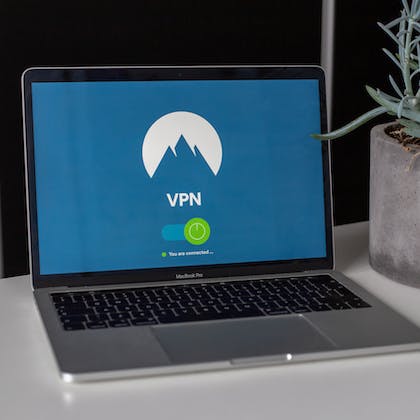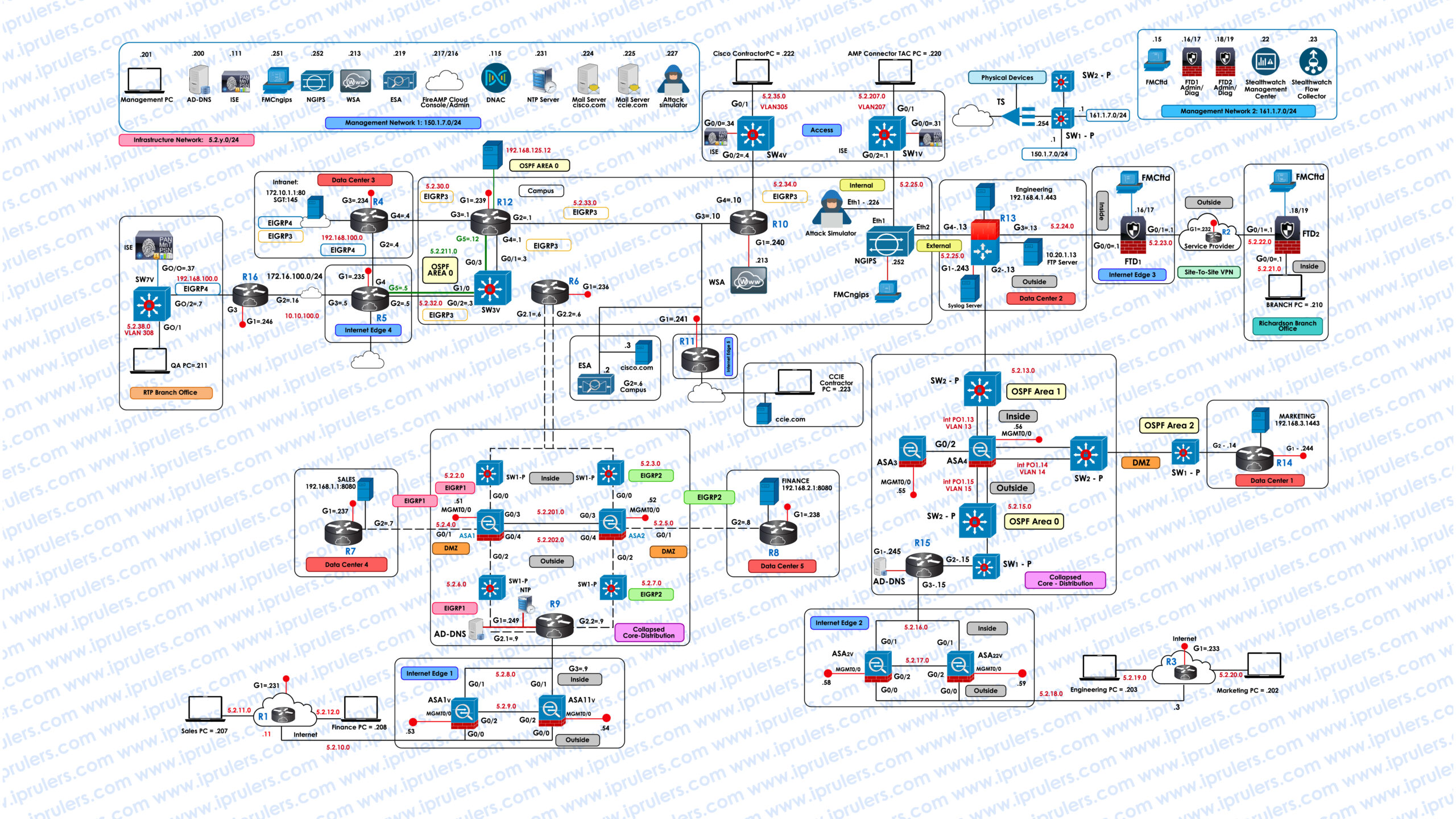

EXPLORE.PERSIST.MASTER.
CCIE Security v6.1 Certification and Training.
Share :
+971 43346660
CCIE Security Certification v6.1 is the highest and most prestigious certification from Cisco. It ranks No. 1 in the 10 Most Difficult IT Certifications list and is highly-valued worldwide. A CCIE certified individual is an elite title in the field of network engineering, proving their mastery in their domain of Cisco networking. The CCIE Security Certified experts have the knowledge and skills required to architect, engineer, implement, troubleshoot, and support the full suite of Cisco security technologies, using the latest methods to protect systems and environments against every kind of modern security risks, threats, and vulnerabilities.
The CCIE Security v6.1 program is designed to include direct exposure on real Cisco Routers, Switches, Cisco ASA Firewalls, FirePower, WSA, ESA, FireAMP, Stealthwatch, Umbrella and NGIPS. The quality of the program, the testing methods, and the relevance of this certification enhances its value. At IPRulers, the classes are facilitated by CCIE Security certified and experienced instructors, and students will be exposed to the latest equipment’s. With grouped as well as one-to-one classes and online tutorials that could be scheduled for weekdays or weekends in accordance to the students’ choice, IPRulers is fast becoming a leading name in Dubai, UAE in achieving high-value Cisco Certification with a significant pass rate on the first attempt.
Target Audience:
- Network engineers attempting the core exam – Implementing and Operating Cisco Enterprise Network Core Technologies (ENCOR 350- 401 v1.1).
- Network engineers who have five to seven years of professional experience in designing, deploying, operating and optimizing enterprise networking technologies.
- Network designers who design and support complex network technologies and topologies.
- Network engineers who use an expert-level problem-solving process (including options analysis) to support complex network technologies and topologies.
- IT students and professionals seeking strong expertise in the subject and an internationally recognized qualification in the same for prospective jobs.
- Candidates with CCNP R&S Certification, moving on to expert levels.
- Aspirants in the following job profiles:
- Network Designer
- Network Administrator
- Consulting Systems Engineer
- Technical Solutions Architect
- Network Manager
- Cisco Integrators and partners
Prerequisites:
- The CCIE Enterprise Infrastructure does not require any particular qualification for attendance of the course. However, comprehensive knowledge of the subjects is necessary for attending the examinations.
- Five to seven years’ experience in networking field, especially in designing, deploying, operating and optimizing security technologies will be an advantage to attempt the CCIE examination.
- Job roles of elite executives in the fast-paced world of Enterprise network .
- Industry-level knowledge and direct experience in implementation of core Cisco enterprise infrastructure solutions.
- Ability to recognize customer requirements and support proposed solutions.
- Enhanced job opportunities with sky-high career growth, coupled with respectable compensations.
- Expertise in all stages of implementing complex networking solutions – from creation and analysis, to operation and optimization.
- Essential skills in networking automation and network programmability in the fast-changing world of technology.
- Specialist Certification for clearing the qualifying exam.
- Authority to link the CCIE Certification Badge to all social media profiles.
Duration
120
Skill Level
Expert
Certificate
Yes
Modules
5
Language
English
Mode
Online/Offline
Key Highlights
- Live Instructor-Led Training
- 120 Hours of Technology Lectures
- 40 Hours of Lab Preparation
- Weekdays (Tue - Fri)
- Weekend (Fri-Sat or Sat-Sun)
- Boot Camp Training for a Fast Track Learning
- Written Question Bank to Clear SCOR
- Eve-ng Set up on the laptop with images
- A workbook intended for the technology lectures
Key Highlights
- Hands-on Lab Practice
- Most Updated and Passable Workbook
- Unlimited Real Rack Access Until you pass or a Version Change
- Support Until you pass or a Version Change
- Detailed Explanation of the Real Lab Solution by the Expert
- Individual Attention given once the real lab preparation started
- 24/7 Access to the Learning Resources
- Flexible Installment Plans
- Instructor support is readily accessible via Email & Whatsapp
Course Curriculam
1.1 Deployment modes on Cisco ASA and Cisco FTD
- Routed
- Transparent
- Single
- Multi-Context
- Multi-Instance
1.2 Firewall features on Cisco ASA and Cisco FTD
- NAT
- Application inspection
- Traffic zones
- Policy-based routing
- Traffic redirection to service modules
- Identity firewall
1.3 Security features on Cisco IOS/IOS-XE
- Application awareness
- Zone-Based Firewall (ZBFW)
- NAT
1.4 Cisco Firepower Management Center (FMC) features
- Alerting
- Logging
- Reporting
- Dynamic Objects
1.5 NGIPS deployment modes
- In-Line
- Passive
- TAP
1.6 Next Generation Firewall (NGFW) features
- SSL inspection
- user identity
- geolocation
- AVC
1.7 Detect, and mitigate common types of attacks
- DoS/DDoS
- Evasion Techniques
- Spoofing
- Man-In-The-Middle
- Botnet
1.8 Clustering/HA features on Cisco ASA and Cisco FTD
1.9 Policies and rules for traffic control on Cisco ASA and Cisco FTD
1.10 Routing protocols security on Cisco IOS, Cisco ASA and Cisco FTD
1.11 Network connectivity through Cisco ASA and Cisco FTD
1.12 Correlation and remediation rules on Cisco FMC
2.1 AnyConnect client-based remote access VPN technologies on Cisco ASA, Cisco FTD, and Cisco Routers.
2.2 Cisco IOS CA for VPN authentication
2.3 FlexVPN, DMVPN, and IPsec L2L Tunnels
2.4 VPN high availability using
- Cisco ASA VPN clustering
- Dual-Hub DMVPN deployments
2.5 Infrastructure segmentation methods
- VLAN
- PVLAN
- GRE
- VRF-Lite
2.6 Micro-segmentation with Cisco TrustSec using SGT and SXP
3.1 Device hardening techniques and control plane protection methods
- CoPP
- IP Source routing
- iACLs
3.2 Management plane protection techniques
- CPU
- Memory thresholding
- Securing device access
3.3 Data plane protection techniques
- uRPF
- QoS
- RTBH
3.4 Layer 2 security techniques
- DAI
- IPDT
- STP security
- Port security
- DHCP snooping
- RA Guard
- VACL
3.5 Wireless security technologies
- WPA
- WPA2
- WPA3
- TKIP
- AES
3.6 Monitoring protocols
- NetFlow/IPFIX/NSEL
- SNMP
- SYSLOG
- RMON
- eStreamer
3.7 Security features to comply with organizational security policies, procedures, and standards BCP 38
- ISO 27001
- RFC 2827
- PCI-DSS
3.8 Cisco SAFE model to validate network security design and to identify threats to different Places in the Network (PINs)
3.9 Interaction with network devices through APIs using basic Python scripts
- REST API requests and responses
- HTTP action verbs, error codes, cookies, headers
- JSON or XML payload
- Authentication
- Data encoding formats
- JSON
- XML
- YAML
3.10 Cisco DNAC Northbound APIs use cases
- Authentication/Authorization
- Network Discovery
- Network Device
- Network Host
4.1 ISE scalability using multiple nodes and personas.
4.2 Cisco switches and Cisco Wireless LAN Controllers for network access AAA with ISE.
4.3 Cisco devices for administrative access with ISE
4.4 AAA for network access with 802.1X and MAB using ISE.
4.5 Guest lifecycle management using ISE and Cisco Wireless LAN controllers
4.6 BYOD on-boarding and network access flows
4.7 ISE integration with external identity sources
- LDAP
- AD
- External RADIUS
4.8 Provisioning of AnyConnect with ISE and ASA
4.9 Posture assessment with ISE
4.10 Endpoint profiling using ISE and Cisco network infrastructure including device sensor
4.11 Integration of MDM with ISE
4.12 Certificate-based authentication using ISE
4.13 Authentication methods
- EAP Chaining
- Machine Access Restriction (MAR)
4.14 Identity mapping on ASA, ISE, WSA, and FTD
4.15 pxGrid integration between security devices WSA, ISE, and Cisco FMC
4.16 Integration of ISE with multi-factor authentication
4.17 Access control and single sign-on using Cisco DUO security technology
5.1 AMP for networks, AMP for endpoints, and AMP for content security (ESA, and WSA)
5.2 Detect, analyze, and mitigate malware incidents
5.3 Perform packet capture and analysis using Wireshark, tcpdump, SPAN, ERSPAN, and RSPAN
5.4 DNS layer security, intelligent proxy, and user identification using Cisco Umbrella
5.5 Web filtering, user identification, and Application Visibility and Control (AVC) on Cisco FTD and WSA.
5.6 WCCP redirection on Cisco devices
5.7 Email security features
- Mail policies
- DLP
- Quarantine
- Authentication
- Encryption
5.8 HTTPS decryption and inspection on Cisco FTD, WSA and Umbrella
5.9 SMA for centralized content security management
5.10 Cisco advanced threat solutions and their integration: Stealthwatch, FMC, AMP, Cognitive Threat Analytics (CTA), Threat Grid, Encrypted Traffic Analytics (ETA), WSA, SMA, CTR, and Umbrella
lab infrastructure.

CCIE Security v6.1 equipment and software list:


The practical exam tests candidates on solutions that can be configured using the equipment and software versions below. Candidates may see more recent software versions during their attempt, but they will be tested only on features in this list.
Passing the exam requires a depth of understanding that is difficult to obtain without hands-on experience. Early in your preparation, you should arrange access to equipment and software like that used on the exam.
Virtual machines
- Cisco Identity Services Engine (ISE): 3.1.0
- Cisco Web Security Appliance (WSA): 9.2
- Cisco Email Security Appliance (ESA): 11.1
- Cisco Firepower Management Center Virtual Appliance: 7.1
- Cisco Firepower Management Center Virtual Appliance: 6.2
- Cisco Firepower NGIPSv: 7.0
- Cisco Firepower Threat Defense: 6.2
- Cisco Adaptive Security Virtual Appliance (ASAv): 9.4(3)
- Cisco CSR 1000V Series Cloud Services Router: 15.5.(3), 16.6.3
- Cisco Stealthwatch SMC-FC: 6.10
- Cisco FireAMP Cloud: 5.3
- Cisco Wireless Controller (WLC): 8.3
- Cisco DNA Center Release 2.2.2.4
- L2IOSv: 15.2

Physical Equipment
- Cisco Adaptive Security Appliance: ASA5512: 9.2
- Cisco Adaptive Security Appliance: ASA5516: 9.8
- Cisco Catalyst Switch: C3650: 16.6
- Cisco Catalyst Switch: C3850: 3.7
- Cisco Wireless Access Point: AP1852: 8.3
Cloud-Delivered
- Cisco Umbrella
Topology

Modes Of Training
We provide various modes of training, each catering to different learning styles, preferences, and needs.You can make your choice of training mode.
- Classroom-Based Training
- One-On-One Training
- Online Training
- Corporate Training
- Fast Track Training
- Private Group Training
- Lab Workshop Training
Instructors

MD & Founder
4XCCIE (R&S, Security, Collaboration, DC), PCNSE & NSE7
Gigi Vikraman a quadruple CCIE has over 15 years of experience working in the Cisco networking field consulting and training. In addition, he has designed, implemented and supported numerous enterprise networks. He has been a dedicated CCIE instructor for over 10 years. He has extended his service in producing 400+ CCIE’s all over the world. Apart from all these, he has already proven his well knowledge in giving training on Fortinet, Palo Alto and Check Point.
MCSE,RHCE,CCNP,CEH,CSA,CCSE,F5-CTS, AWS & Azure

Babu Varghese
Senior Cloud & Security Specialist
Our student success stories

Shyam
CCIE #67032
CCIE Security

Syed Abrar
CCIE #66899
CCIE Security

Noorudheen
CCIE #2x57477
CCIE Security

Sajeesh
CCIE #66886
CCIE Security

Ameersha
CCIE #66706
CCIE Security

Sujit Nair
CCIE #66664


